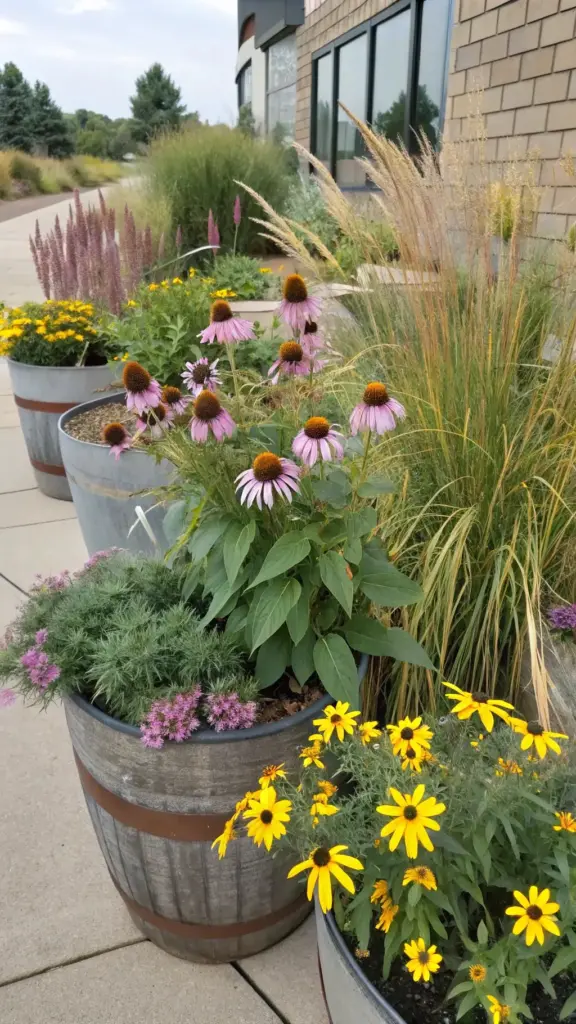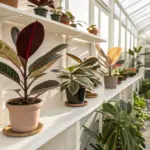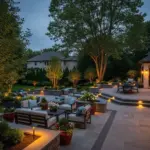6. Drought-Tolerant Native Plant Showcase

I used to be that person who watered my containers twice a day during summer heat waves, watching my water bill skyrocket while my non-native plants still looked stressed and miserable. It was exhausting and expensive.
Then I discovered the magic of native plant containers during a particularly brutal drought year when water restrictions forced me to get creative. That’s when I realized I’d been fighting against nature instead of working with it.
Now my drought-tolerant native showcase thrives with minimal water while attracting more butterflies and birds than I ever imagined possible!
Regional Native Plant Powerhouses
Purple coneflower (Echinacea) is my absolute favorite native for containers. These tough perennials bloom for months and come back stronger each year.
In the Southwest, desert marigold and penstemon create stunning displays that laugh at 100-degree heat. These plants actually prefer neglect over constant attention.
Black-eyed Susan works beautifully in most climate zones and provides that cheerful yellow color that photographs amazingly well. Plus, goldfinches go crazy for the seeds in fall.
Regional variations matter more than you think. What thrives in Texas won’t necessarily work in Minnesota, so I always check with my local native plant society for recommendations.
Water-Wise Gardening That Actually Works
Deep, infrequent watering changed everything for my native containers. Instead of daily sprinkles, I water thoroughly once or twice a week and let the soil dry between waterings.
Mulching is absolutely crucial for water retention. I use shredded bark or gravel mulch to keep soil moisture consistent and reduce evaporation.
Self-watering containers work great for natives too, but I adjust the water reservoir size smaller than I would for thirsty annuals.
Grouping containers by water needs prevents overwatering some plants while underwatering others. My native containers get grouped separately from my tropical displays.
Supporting Local Wildlife Magic
The pollinator activity around my native containers is incredible. I counted 12 different butterfly species on my purple coneflower container last summer!
Native bees prefer native plants by a huge margin. My containers buzz with activity from tiny sweat bees to chunky bumblebees all season long.
Bird watching from my kitchen window became my new hobby after planting natives. Goldfinches, chickadees, and even hummingbirds visit my containers regularly.
Beneficial insects like ladybugs and lacewings help control pests naturally. My native containers rarely have aphid problems because the good bugs keep everything balanced.
Long-Term Cost Savings Reality
Water bill reduction was immediate and dramatic. My summer water usage dropped by 30% the first year I switched to predominantly native containers.
Perennial natives come back bigger each year, unlike annuals that need replacing. My initial investment pays dividends for years.
Fertilizer costs basically disappeared because native plants don’t need the constant feeding that exotic plants require. They’re adapted to local soil conditions.
Replacement costs are minimal since native perennials are incredibly long-lived. Some of my original plants are going on their fifth year and still thriving.
Creating Cohesive Design Magic
Texture variation is key to making native containers look intentional rather than random. I combine fine-textured grasses with broad-leafed perennials and spiky plants.
Height layering creates visual interest without looking chaotic. Tall native grasses in back, medium perennials in middle, and low groundcovers spilling over edges.
Color coordination with natives is easier than you think. I stick to a palette of purples, yellows, and whites that naturally occur together in local prairies.
Seasonal interest keeps containers looking good year-round. Native grasses provide winter structure while perennials offer spring through fall blooms.
Regional Adaptation Strategies
Climate zone research is essential before choosing plants. I use the USDA hardiness zone map and local extension office resources to make smart choices.
Microclimates on your property affect plant selection. My south-facing containers get different natives than my shadier north-side spots.
Soil preferences vary among natives. Some prefer sandy, well-draining soil while others tolerate clay. I match plants to appropriate soil mixes.
Local ecotypes perform better than generic native varieties. I source plants from nurseries that grow local seed sources whenever possible.
Maintenance That’s Actually Minimal
Fall cleanup is optional with many natives. I leave seed heads for birds and cut back in early spring instead of fall.
Dividing perennials every 3-4 years gives me free plants to expand my collection or share with neighbors. It’s like getting paid to garden!
Pest problems are rare because native plants have natural resistance to local pests. I rarely need to intervene with any treatments.
Watering schedules become almost nonexistent after the first year. Established natives handle normal rainfall with minimal supplemental watering.
Design Inspiration from Nature
Prairie-style combinations work beautifully in large containers. I mix native grasses with wildflowers for that natural meadow look.
Woodland natives create stunning shade containers. Wild ginger, coral bells, and native ferns thrive in shadier spots.
Desert-inspired designs using succulents and drought-adapted natives create striking architectural displays that need almost no water.
Coastal combinations with salt-tolerant natives work perfectly for seaside locations or areas with winter salt spray.
Photography Tips for Native Beauty
Golden hour lighting makes native grasses glow like they’re backlit. Early morning or late afternoon shots capture this magical quality.
Macro photography of native flowers reveals incredible details that people miss with casual observation. Native bee visitors add action to shots.
Seasonal progression photos document how natives change throughout the year. Spring emergence, summer blooms, fall seed heads, and winter structure tell a complete story.
Wildlife interaction shots get amazing engagement on social media. Butterflies on coneflowers or birds eating seeds create compelling content.
Conclusion
These six full sun planter ideas prove that you don’t need a sprawling garden to create outdoor magic!
Each container garden offers something special – from the Instagram-worthy succulent paradise to the practical herb garden that’ll elevate your dinner parties.
The best part? You can start with just one planter this weekend and gradually build your collection as your confidence grows. Remember, gardening isn’t about perfection; it’s about creating a space that brings you joy every single day.
So grab your favorite coffee mug, head to your local nursery, and pick the planter idea that speaks to your style. Your future self (and your summer entertaining guests) will thank you for taking action today!









GIPHY App Key not set. Please check settings